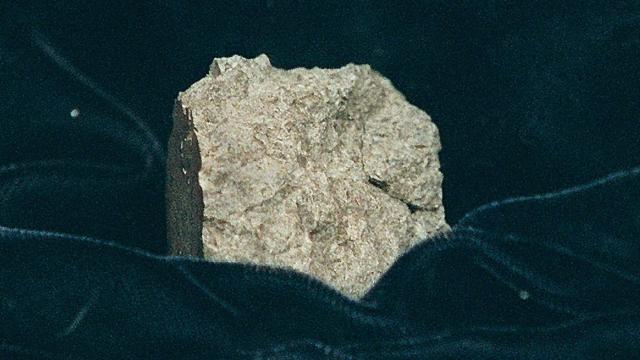Apparent fossils on the Allan Hills 84001 meteorite — a chunk of rock that formed on Mars some 4 billion years ago — were produced by water and not microbial Martians, according to new research. But the scientists behind the original fossil claim aren’t convinced.
The 4-billion-year-old fragment formed on Mars during the Red Planet’s turbulent Noachian period, was jettisoned to space by a giant impact around 17 million years ago, and landed on Earth some 13,000 years ago. Named for the Antarctic Allan Hills in which it was found, the 1.94 kg meteorite is among the oldest ever recovered.
A NASA-led group of scientists shocked the world in 1996 by daring to suggest that the worm-like carbonate globules on the meteorite were fossils, and therefore the first evidence of alien life. Many scientists questioned this interpretation, positing other theories for the alleged “biomorphs,” such as volcanic activity, impact events, and exposure to water. Most scientists agree that evidence of life is absent on ALH84001, but the debate continues after more than a quarter century.

The latest chapter in this saga appeared on Thursday — a new paper in Science that once again makes the case for abiotic processes as being responsible for the features seen on the meteorite. The new paper specifically argues that the organic molecules found on the meteorite formed from slow and steady interactions caused by groundwater sifting through cracked rocks. Astrobiologist Andrew Steele from the Carnegie Institution for Science led the new research.
Now, just because something is described as “organic” doesn’t necessarily mean it has anything to do with life. Organic molecules are typically composed of carbon and hydrogen, and sometimes oxygen, nitrogen, and sulphur. Sure, these molecules are often associated with biological processes, but they can arise from abiotic processes as well, in what’s known as abiotic organic chemistry.
Of relevance to the new research, “Mars rovers have found complex organic molecules in the ancient rocks exposed on the planet’s surface and methane in the modern atmosphere,” the new paper reminds us. “It is unclear what processes produced these organics, with proposals including both biotic and abiotic sources.” It’s by analysing the origin of minerals on ALH84001 that the team sought to better understand the “geochemical processes occurring early in Earth’s history and Mars’ potential for habitability,” Steele, a member of NASA’s Perseverance and Curiosity science teams, explained in a Carnegie press release.
Indeed, the new research is more than an effort to debunk the claim that ALH84001 contains Martian fossils. This research also speaks to the early conditions on Mars and Earth, how these conditions possibly set the groundwork for life to emerge, and why Mars exhibits the features we see today, such as the presence of methane. The “search for life on Mars is not just an attempt to answer the question ‘are we alone?’,” said Steele. “It also relates to early Earth environments and addresses the question of ‘where did we come from?’”
Steele and his colleagues used nanoscale microscopic imaging, spectroscopy, and an isotopic analysis to study the meteorite, leading them to conclude that the organic molecules formed as the result of interactions between water, likely salty or briny water, and basalt rocks.
The paper says one of two possible geochemical processes were responsible for the organic synthesis: serpentinization and carbonization. In serpentinization, igneous rocks rich in iron or magnesium interact with circulating water, resulting in the production of hydrogen, and in carbonization, acidic water containing dissolved carbon dioxide interacts with rocks, resulting in carbonates.
The scientists say it’s not obvious which of the two is responsible or the exact sequence of events, but they do say it transpired over a prolonged period, that reactions produced organics from the reduction of carbon dioxide, and that abiotic processes alone were responsible for the carbon-rich compounds.
The scientists behind the 1996 study aren’t impressed with the new paper, as The Guardian reports. They say it offers nothing new and that the interpretation isn’t supported by any evidence, adding that “[u]nsupported speculation does nothing to resolve the conundrum surrounding the origin of organic matter” in the meteorite.
So the debate rages on. But this single rock won’t answer the question as to whether life once existed, or still exists, on Mars. For that, our best current option is a sample return mission, which thankfully is already underway. NASA’s Perseverance rover is currently collecting and depositing surface samples for a future mission to bring to Earth, possibly in the early 2030s.
